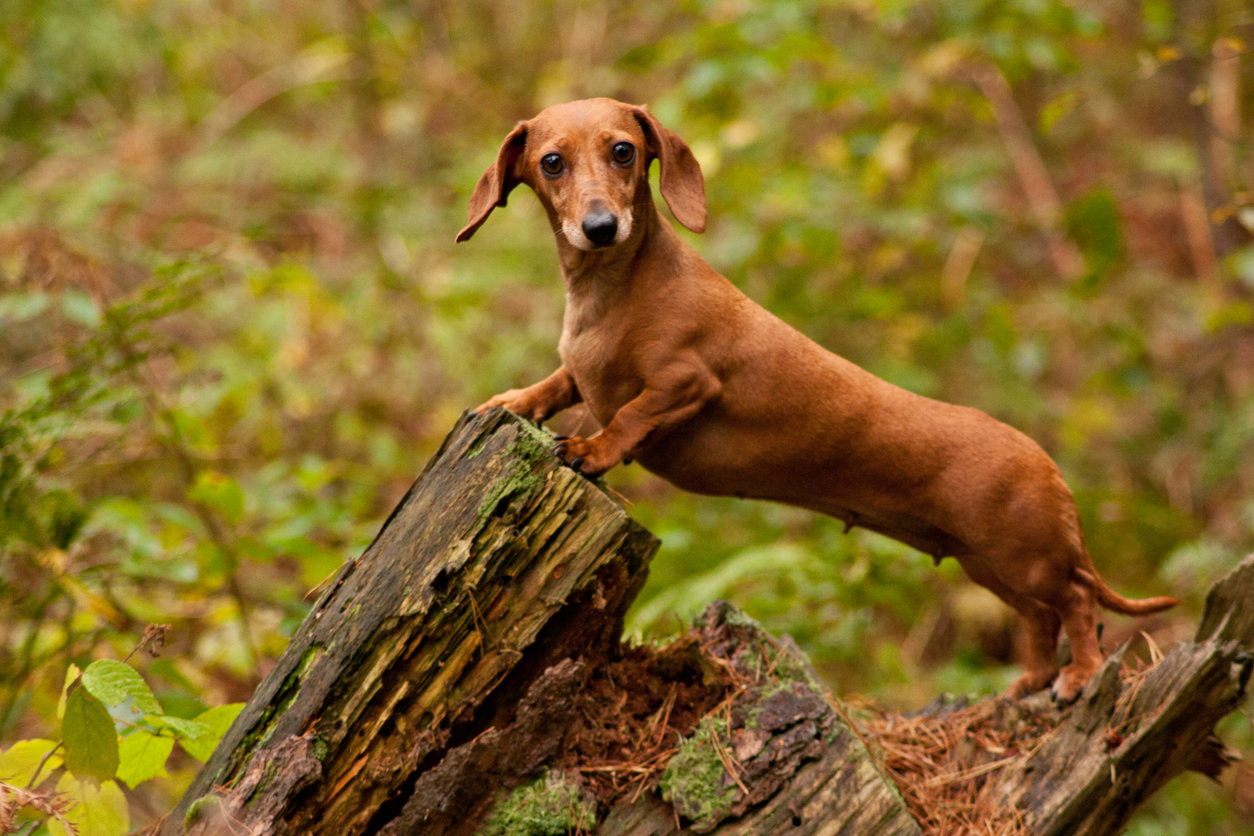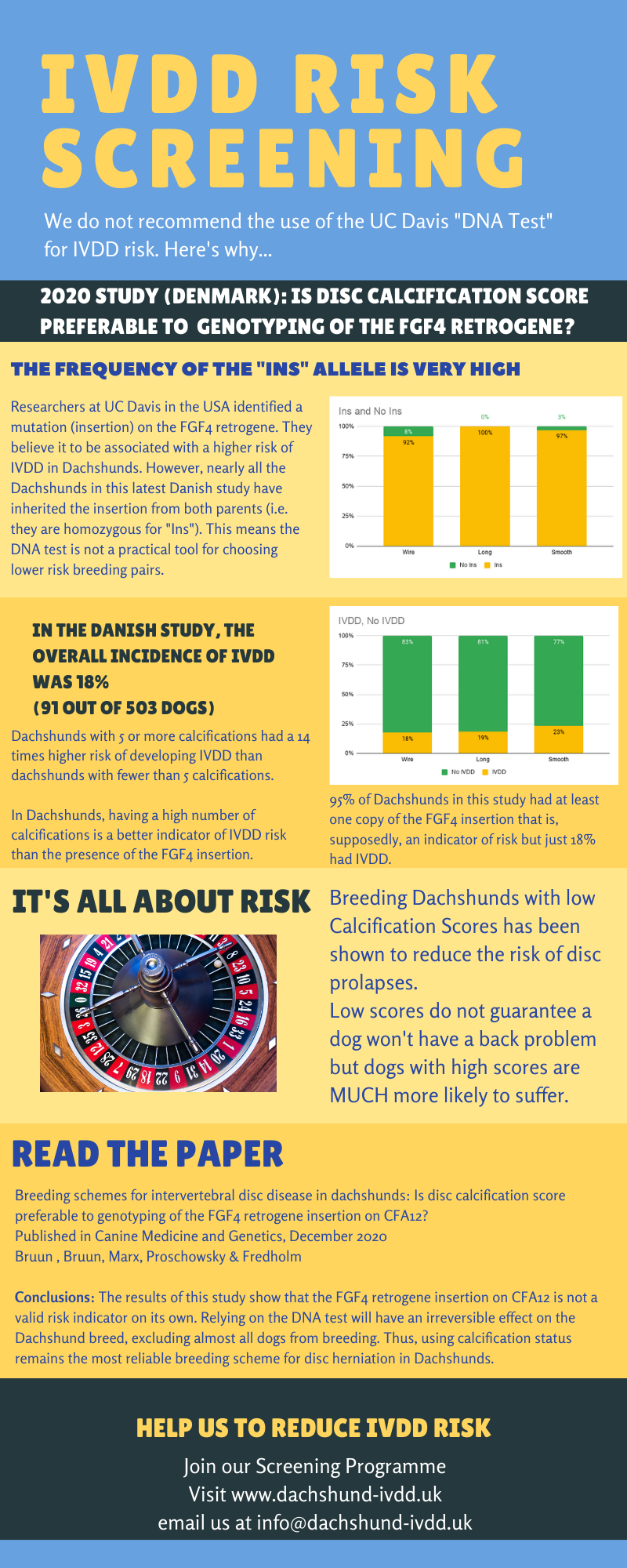| print
link to this post | email a friend Chondrodysplasia, Chondrodystrophy, and Genetic Testing11 Nov 2023 By Laurie Edge-Hughes, BScPT, MAnimSt (Animal Physio.), CAFCI, CCRT, Cert.Sm.Anim.Acup./Needling
Many people are unaware of the fact that there is a genetic test for chondrodysplasia / chondrodystrophy (i.e. wiener dogs / sausage dogs / short-legged-long-backed dogs). Sure, you can look at any Dachshund and presume it has the genes for chondrodystrophy, but did you know that it also shows up in other dogs that you wouldn’t expect (i.e. Standard Poodle, Labrador Retriever, Nova Scotia Duck Tolling Retriever, etc.)? Since chondrodysplasia tends to have a high association with disc disease (‘blowing a disc’), there is talk that perhaps we need to increase the number of genetic tests conducted for the gene. While I have mixed feelings about this assertion, it warrants further investigation. Hence this blog!
So, let’s start with definitions: From the UC Davis, School of Veterinary Medicine, Veterinary Genetic Laboratory (VGL)1:
Phenotype: Dogs with chondrodysplasia (CDPA) have short legs; this phenotype is characteristic of many breeds such as Corgis and Dachshunds. Chondrodystrophy (CDDY), caused by a separate mutation, also includes a short-legged phenotype as well as abnormal premature degeneration of intervertebral discs (also referred to as intervertebral disc disease, IVDD). These degenerated discs are susceptible to herniation. Multiple factors are thought to influence whether a particular disc herniates in an individual dog.
Mode of Inheritance: Chondrodysplasia (CDPA): Autosomal dominant (for the height / appearance of the dog) Chondrodystrophy (CDDY): Autosomal dominant for intervertebral disc disease, & semi-dominant for height
Additional Information: Shorter legs in dogs are explained by two retrogene insertions of functional fibroblast growth factor 4 (FGF4). FGF4 gene is involved in many biological processes including bone development.
Parker et al (2009) discovered the first gene mutation, FGF4 in chromosome 18, which accounts for the short legged phenotype chondrodysplasia (CDPA). Brown et al (2017) discovered the second gene mutation, FGF4 in chromosome 12, which produces the chondrodystrophy (CDDY) aspects of both short legs and a higher incidence of Hansen’s Type 1 IVDD (e.g. accelerated rate of disc degeneration and tendency to herniation).
The CDDY variant has been found in many breeds such as Alpine Dachsbracke, American Cocker Spaniel, Australian Shepherd, Basset Hound, Bavarian Mountain Hound, Beagle, Bichon Frise, Boykin Spaniel, Cardigan Welsh Corgi, Cavalier King Charles Spaniel, Chesapeake Bay Retriever, Chihuahua, Chinese Crested, Clumber Spaniel, Coton de Tulear, Dachshund, Dandie Dinmont Terrier, Danish Swedish Farmdog, English Springer Spaniel, Entlebucher Mountain Dog, French Bulldog, German Hound, Havanese, Jack Russell Terrier, Maltese, Nova Scotia Duck Tolling Retriever, Pekingese, Pembroke Welsh Corgi, Pinscher (Miniature), Poodle (Miniature and Toy), Poodle (Standard), Portuguese Water Dog, Pug, Rat Terrier, Russian Tsvetnaya Bolonka, Schweizer Laufhund, Schweizerischer Niederlaufhund, Scottish Terrier, Sealyham Terrier, Shih Tzu, Skye Terrier, and Yorkshire Terrier. (Batcher et al 2019)
Should this genetic test be used for selective breeding against IVDD?
Now here’s the part that’s interesting. A Danish study group (Bruun et al 2020) investigated the incidence of disc herniation in the smooth-haired, long-haired and wire- haired Dachshund populations. They also evaluated and compared the accuracy of the two breeding schemes predicting the risk of disc herniation: the DNA test and the radiography based scheme.
The long and short of it, is that almost all dachshunds will have the FGF4 mutation on chromosome 12 (97.9% according to the UC Davis Veterinary Genetics Laboratory). However, the overall incidence of disc herniation in Danish Dachshunds was only 18%. They found a significant association between calcification status and the risk of disc herniation. Dogs with ≥5 calcifications have a 14 times greater risk of developing intervertebral disc herniation compared to dogs with < 5 calcifications.
The authors concluded that relying on the DNA test will have an irreversible effect on the Dachshund breed excluding almost all dogs from breeding. Thus, using calcification status remains the most reliable breeding scheme for disc herniation in Dachshunds.
Other thoughts?
What we don’t really know about are the other breeds that surprisingly showed up in the VGL reference library. For example, Nova Scotia Duck Tolling Retrievers, of which 1508 have been tested, have a CCDY frequency of 35.8%. Australian Shepherds (10 sampled) display a 10% frequency, Chesapeake Bay Retrievers (35 sampled) display an 8.6% frequency, and Standard Poodles (57 sampled) have a 5.3% frequency of the CCDY mutation.
What do we do with this information? If almost 100% of the Dachshund population has the CCDY mutation, but only 18% develop a disc herniation, would that mean that in the Duck Tolling Retrievers (using the numbers above), only 6.4% of these dogs would develop IVDD? Is it then worth eliminating 1/3 of the breeding population to clear it of this gene mutation? Would breeding a CCDY carrier to a Normal dog, thus reducing the risk by 50% be a worthwhile venture?
Time will tell what we do with this test, but in the meantime, isn’t it interesting!!!
References:
1. Chondrodystrophy (CDDY and IVDD) and Chondrodysplasia (CDPA). https://vgl.ucdavis.edu/test/cddy-cdpa (accessed June 14, 2023). 2. Parker, H.G., VonHoldt, B.M., Quignon, P., et al (2009). An expressed fgf4 retrogene is associated with breed-defining chondrodysplasia in domestic dogs. Science, 325(5943), 995-998. 3. Brown, E.A., Dickinson, P.J., Mansour, et al (2017). FGF4 retrogene on CFA12 is responsible for chondrodystrophy and intervertebral disc disease in dogs. Proceedings of the National Academy of Sciences of the United States of America, 114(43), 11476-11481. 4. Batcher, K., Dickinson, P., Giuffrida, et al (2019). Phenotypic Effects of FGF4 Retrogenes on Intervertebral Disc Disease in Dogs. Genes, 10, 435. 5. Bruun, C.S., Bruun, C., Marx, T. et al. Breeding schemes for intervertebral disc disease in dachshunds: Is disc calcification score preferable to genotyping of the FGF4 retrogene insertion on CFA12?. Canine Genet Epidemiol 7, 18 (2020).
|

|


